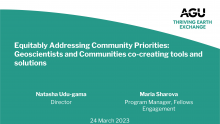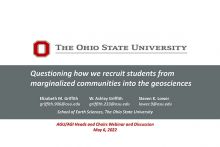In this webinar, Dave Mogk (Montana State University) and Steven Whitmeyer (James Madison University) lead the discussion about current and future trends in geoscience field camps and how burgeoning enrollments and new technology are impacting this core geoscience course.
Related Files:
 Future of Field Camp presentation slides
Future of Field Camp presentation slides EOS: Geoscience Field Education - A Recent Resurgence (by permission of AGU)
EOS: Geoscience Field Education - A Recent Resurgence (by permission of AGU) EOS: Safety and Liability Issues Related to Field Trips and Field Courses (by permission of AGU)
EOS: Safety and Liability Issues Related to Field Trips and Field Courses (by permission of AGU)
Additional Questions and Answers from the Webinar
We ran out of time for questions and answers. Below are a number of the questions that we did not have time to respond to, with reponses from the presenters. DM is a response from Dave Mogk. SJW is a response from Steve Whitmeyer.
A comment that offering an introductory field course does help draw in majors, but it also serves a population that is broader than just the geology department. This has been important at Michigan in getting the College to support our field camps, that we are serving students across the College and not just in our own discipline.
DM: U Michigan is fortunate to have a dedicated field camp facility near Jackson Wy which they have used very effectively to include students from across many departments by offering courses (I believe) in Environmental Sciences, Energy, and Writing Composition. Inviting allied disciplines, and maybe those not so closely allied, is a great way to extend awareness of the geosciences to these much broader audiences. It’s really important that our colleagues in other disciplines have some understanding of geologic habits of mind (deep time, spatial reasoning, complex systems….)
For the Digital Mapping gurus: Is the visibility of the screen in sunny vs cloudy conditions a serious issue with iPads and other pad computers? Is there a good solution to this?
DM: This is one for Steve, but I think the technology has come a long way to improve visibility in outside conditions.
SJW: Screen lighting in outside conditions has gotten better, but there is still significant room for improvement in table screen brightness. Ironically, Trimble devices solved this program years ago by incorporating backlighting to the screens of their mobile devices. Unfortunately, iPads and Android tablets haven’t seen the light yet.
Comment: increasing enrollments needs to be addressed, However too many students can lead to student anonymity and compromise learning.
DM: I agree completely about the negative impacts of high enrollments. Two thoughts: 1) This is why I suggested a national network of field camp “nodes” to try to distribute the students among many camps, utilizing faculty and resources from many institutions; 2) John Geissman asked about student: instructor ratio, and the AAPG – Exxon/Mobil Field Safety guide recommends a ratio of about 7 to 1 to handle instruction, logistics, safety.
Have any of you run into ADA compliance issues with your institutions?
DM: To date we haven’t had many issues regarding ADA, although we have had one woman blow out her knee (skiing) before field camp, and another older student who was not able to physically do the geologic mapping exercises and withdrew with an Incomplete. In both cases, we were allowed to offer equitable work effort for the students to complete the course. This generally involved some sort of remote sensing (air photo, now Google Earth) based mapping with ground checks along National Forest roads for ease of access. Not the same experience by any means, but still we were able to get the students into the field, making measurements, describing rocks and structures, writing a report. This is a topic that needs much wider discussion.
SJW: We have had ADA issues, and field course directors need to be very aware of this. I suspect that your institutions will require ADA compliance, so you should be proactive and have a plan in place for how you will accommodate students with physical limitations.
Are there resources that speak on how to use field camp as a program assessment tool? With rubrics, examples, etc?
DM: Again, a great topic for future discussion. I got this idea from Darrell Henry at LSU who was in charge of their overall institutional accreditation review. I’m not sure of any existing rubrics or instruments that exist. But, my basic idea was to encourage departments to think clearly about their overall goals for student learning outcomes: what should students know and be able to do when they leave your program? If your field camp is designed as a “capstone” course, then it should be a good vehicle to measure long-term learning about e.g. rock and mineral ID, geologic structures, landforms, etc. There are also skill goals: making measurements, recording notes. Higher order thinking goals: synthetic and analytical reasoning, etc. I prepared a matrix of student learning outcomes for our department which I posted on the Earth and Mind blog: http://serc.carleton.edu/earthandmind/posts/curriculum_desi2.html This gives you some idea of the types of programmatic goals you might consider, and then see how your field cap aligns with these goals.
I missed what you said about field methods vs field camp. Many of my structure students want to enter my field camp w/o prereqs because they've had 'field studies.' My reaction is no, but it seems ubiquitous.
DM: Many departments have a dedicated Field Methods class that may be used as a prerequisite for a Field Camp (and in some cases as a substitute for). Other departments emphasize field methods “across the curriculum” as field skills are introduced in courses such as Structural Geology, Geomorphology, etc. I just think it’s a good idea to identify the essential field skills needed for successful completion of a Field Camp, and make sure that the students are well-prepared with the basics going into the Field Camp. Students already have a huge cognitive load in dealing with all the challenges of a field experience, and they will do much better if they know their way around a Brunton or Silva before they find themselves in Terra Incognito in the field setting.
Does either Dave or Steve know of any efforts to take geo- or rock-focused mapping over to soils?
DM: I really don’t know of any soil-focused Field Camps. Increasingly, there are Field Camps that are focused on Environmental Geology, and soil identification (perhaps not mapping) may be an important part of that experience. We also do some trenching across active fault scarps here in Montana as part of our active tectonics unit in our Field Camp , and that has a major soils component.
The biggest challenge facing my department, in which we have a field camp requirement, is having sufficient opportunities. We have found that there are not enough field camps out there to accommodate the student need. We have also noted some camps closing. Can you comment on this increasingly problematic issue?
DM: Well, that’s why (I think) we were asked to do this webinar. Yes, it’s a major concern for the profession: too great a need and too little capacity. Here at MSU we petitioned our administration to allow us to increase our field camp up to 30-35 students as we became aware of this challenge. Hopefully other existing camps will do the same, and in aggregate hopefully we can accommodate students who have the need and interest. I made the comment in the webinar that the industries that claim that they value students that have had a robust field camp really must step up and help—financially, perhaps by providing visiting geoscientists, lending modern instrumentation. This is for the good of the profession. The Academy just has too few resources, costs are prohibitive for students, it takes a huge time commitment for instructional faculty….So, if this is really a high priority for pre-professional training, then the professions we serve really have to step up and help.
What is the average cost for a 6 week GFC? and do you foresee 4 week GFCs replacing 6 weeks GFCs?
DM: I’m not sure that we have a good compilation of costs. Perhaps this is something we could ask Penny Morton to compile in her next survey. Factors that vary: 1) In state v. out of state tuition; some programs are able to waive out of state tuition to give a competitive boost for students to enroll in their programs. Our Regents have never given us this option. 2) Lodging: at a central camp (U Michigan, U Indiana, U Missouri, facilities at U Montana – Western in Dillon), camping, on campus with day trips? 3) Food service: centralized at a camp facility, camp cook and logistician to serve everyone; students cook in their own small cooking groups?
What percent of geology programs require a field experience for graduation? One more question - do you think larger camps (60 students) take away from the affective gains?
DM: A survey by Carl Drummond and Jane Markin, An Analysis of the Bachelor of Science in Geology Degree as Offered in the United StatesJournal of Geoscience Education, v. 56, n. 2, March, 2008, p. 113-119, showed that out of 287 departments surveyed, that 99.3 required a field campl So, the demand is great. I’m sure there is an optimal enrollment to provide the optimal experience for students—ability to learn, developing working relations with peers and faculty, sense of “belonging” and contributing to the group…My instinct is that 60 is probably too big a number. A good topic for more study (Heather Petcovic or Eric Riggs!!!!).
For Steve- If contacts/polygons are not implemented well in current field tablets, do you feel that the students are losing important field-reasoning tools involving contacts and three-dimensional relationships.
SJW: I think that drawing polygons in the field is a waste of time. Current field software can color code point and orientation data, so it is easy for students to quick get an overall feel for their field data while in the field. As far as linework is concerned, a case can be made for drawing lines while in the field. Some field GIS programs/apps handle linework pretty well (e.g. GISPro). Others are more focused on point data collection (e.g. GeoFieldBook, iGIS). I can see good arguments for both point data collection and point + line data collection in the field. It is really a matter of how you (as the instructor) want to run your field exercise.
At Missouri S&T we have invited professional geologists and geophysicsts to visit the camp. It has a big impact on the students because no matter how many times you the instructor say something if a geologist from the ""real"" world says something every student views it as extremely important - excellent reinforcement of wht you the ""unreal"" geologist are trying to accomplish.
DM: I agree completely. We visit a number of mines in our field camp, periodically have geologists from the USGS or Forest Service join camp. It’s great to have the affirmation from outside the department.
SJW: Yes, I agree as well. We always have outside “visitors” from other institutions and/or industry professionals at the JMU Ireland field course. I think the students appreciate the outside perspective on what they are doing.
Missouri S&T has gone to a 3 credit 3 week intro (Freshman and Sophmore) and a 3 credit 3 week advanced camp (Junior and Senior) both required. I like this approach for many reasons, however, I have seen requirements based on minimum 4 consecutive weeks in the field. I suggest moving away from this requirement and focus more on what objectives are being met during the camps.
DM: I think that degree requirements are moving towards “competencies” or “outcomes based assessments. Each department will its own path on how to get there (assuming the competencies are well-defined) based on geologic/geographic setting, faculty availability and expertise, and student demographics (e.g. many students may not be able to attend an extended in – residence camp if they are working, family issues, etc.). That’s why I advocate a clear set of student learning outcomes at the program level, and let departments explore the best way to design and develop programs according to their local opportunities and needs. But that’s just my world view.
Chris Keane will have much more to offer here regarding department characterization, competencies, and professional expectations.
How do directors justify pay of teaching staff to campus administration.....does your campus have a set teaching pay, and if so how to you get additional pay for your on site faculty?
DM: This is a huge issue. As Department Head I have to go to the Dean and Provost every year to justify even having a field camp, let alone pay for it. We have no special compensation for field camp director who has to organize the course during the academic year. I’m going to work to provide released time for this extra duty. Our salary is somehow pro-rated by the time spent (number of days) that a faculty is the lead instructor times their base salary. Many of us spend additional days in the field gratis; many of us do project design by visiting field sites ahead of time on our own nickel. It’s not right. But we seem to do it because it’s for the students.
SJW: I think compensation is a big issue everywhere. We all know how time and labor intensive teaching a field course is, yet our faculty actually make more money teaching an intro summer course on campus than they do teaching in the field course. Not sure how to rectify this situation.
Has anyone calculated the probable demand for additional field camp capacity in the near future e.g. 5 and 10 years down the road ?
DM: AGI will be the best source of these projections. I believe that the Status of the Workforce produced by Chris Keane and associates Heather Houlton and Carolyn Wilson will be a good road map for us.
CK: The 2014 Status of Geoscience Workforce report will be released in the next couple weeks. It does address a number of the issues of changing forward demand for geoscientists and the demand for specific skills, like field courses.
What experience have either of you had with field camps or other field experiences for nonscience majors? What literature are you aware of that deal with the unique benefits, issues, and problems associated with these experiences?
DM: There is a pretty substantial literature about engagement of non-science students in field activities. This is largely from the “informal” science community and related disciplines such as Environmental Science. Read Robert Louv’s “Last Child in the Woods “ (about “nature deficit disorder). A number of these references can be found in this compilation bibliography I posted at Cutting Edge. Check the SERC site guide on Teaching in the Field for additional resources: http://serc.carleton.edu/teachearth/site_guides/field.html
From on the Cutting Edge: http://serc.carleton.edu/NAGTWorkshops/field/index.html
Here is the online bibliography I put together for the Earth and Mind II article on Teaching in the Field:
http://serc.carleton.edu/research_on_learning/synthesis/field_resources.html
The full set of references can also be found in our review article on learning in the field:
Mogk, D., and Goodwin, C., 2012, Learning in the Field: Synthesis of research on thinking and learning in the geosciences. In K. Kastens and C. Manduca (eds), Earth and Mind II A Synthesis of Research on Thinking and Learning in the Geosciences, Geol. Soc. Amer. Special Paper 486, pp. 131-161.






